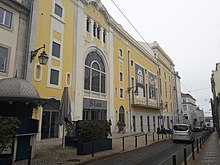Sao Luiz Theater
The Teatro São Luiz (also Teatro Municipal São Luiz and Teatro São Luis ) is a theater in the Portuguese capital, Lisbon .
history
1892-1918
On the initiative of the actor Guilherme de Silveria, and chaired by the Visconde de São Luiz Braga, an association was founded in 1892 to build a new theater. According to the plans of the French architect Louis-Ernest Reynaud in the Rua do Tesoiro Velho (today Rua António Maria Cardoso ) on Chiadoviertelerbaut , named after the king consort theater opened on May 22, 1894 Teatro Dona Amélia opened in the presence of King I. Carlos and of Queen Amélie d'Orléans . The operetta A Filha do Tambor ( La Fille du Tambour-Major ) by Jacques Offenbach was performed, with stage equipment by the Italian Luigi Manini (1848-1936).
In 1896 the theater also received a cinematograph and showed films. However, it remained primarily a theater that was also attended by international actors, such as the French Julia Bartet in 1902 or Mimi Aguglia from Italy in 1909 . In 1910 the house was renamed the Teatro da República after the royal family was overthrown and the Portuguese Republic was proclaimed on October 5, 1910 .
In 1914 a fire completely destroyed the theater. The theater association, whose president was still the Visconde de São Luiz Braga, organized the immediate reconstruction. According to plans by the architect Tertuliano Lacerda Marques , it reopened in 1916 in the presence of President Bernardino Machado . In the same year Almada Negreiros organized the futuristic conference Ultimato Futurista there .
1918-1999
After the Visconde de São Luiz Braga died in 1918, the theater was renamed Teatro São Luiz in his honor . In 1928 the theater was converted into a cinema with equipment by José Leitão de Barros and was named Cine-Teatro São Luiz . Fritz Lang's film Metropolis was shown at the premiere , with music by Pedro Blanc and a 15-piece orchestra conducted by him. In 1919 the winter garden was opened as a further projection room in the theater, with Chianca de Garcias Ver e Amar . In 1930 Augusto Genina's Premio de Beleza (orig .: Prix de beauté) was the first sound film to be shown, and in the same year the first Portuguese sound film was premiered there with A Severa by Leitão de Barros. It was also the premiere cinema for A Canção de Lisboa by Continelli Telmo in 1933, and for A Canção da Terra by Jorge Brum do Canto in 1938.
With the decline in cinema attendance, theater was increasingly played again in the 1950s. The French theater was a guest in 1956, and in 1967 António Marinheiro was performed by the Portuguese dramaturge Bernardo Santareno (1924–1980), with Eunice Muñoz and João Perry in the leading roles.
After the number of visitors continued to decline, the city administration took over the theater in 1971, changing the name accordingly to Teatro Municipal São Luiz . The first piece to be performed was A Salvação do Mundo (English: The salvation of the world) by José Régio , with Eunice Muñoz in the lead role.
Since 1999
Since 1999, extensive modernization work has been carried out on all rooms in various tendering sections, such as the hall, the winter garden, which was converted into a theater studio in 1991, and the cafeteria. After the musical Amália by Filipe La Féria was shown there in the same year, the theater, winter garden, studio ( Sala Mario Viegas ) and Café dos Teatros reopened in 2002 . Since then, the theater has been re-operated with particular activity, with guest names such as Pina Bausch , Terry Jones , Artur Pizarro , Maria João Pires , Ursula Rucker , Amparo Rivelles , Luís Tinoco , Edson Cordeiro , Wim Mertens , and others. a. Also Fado - and jazz concerts were and are held here frequently, and with the annual Festa do Jazz no São Luiz Jazz Festival is here since 2006 organized.
In the wake of the country's financial crisis, the funds for the municipal Teatro São Luiz have also been cut by around 15%. As a result, the jazz festival, for example, took place on only two days instead of the usual three days and could offer less attractive names than in previous years. The house had to accept a decrease of around 10,000 visitors in the 2011/2012 season compared to 2010/2011. Since then, the artistic director José Luís Ferreira has tried, in co-productions with other theaters and a dedicated program selection, to continue to offer a program with lower resources that is able to attract the audience further into the house.
The building has been listed as a monument since 2002.
Web links
Individual evidence
- ↑ Chronology on www.teatrosaoluiz.pt ( Memento of the original from June 29, 2012 in the Internet Archive ) Info: The archive link was inserted automatically and has not yet been checked. Please check the original and archive link according to the instructions and then remove this notice. , accessed September 7, 2012
- ↑ Theater portrait on www.teatrosaoluiz.pt , accessed on September 7, 2012
- ↑ Article from July 2, 2012 ( Memento of the original from May 18, 2015 in the Internet Archive ) Info: The archive link was inserted automatically and has not yet been checked. Please check the original and archive link according to the instructions and then remove this notice. in the Diário de Notícias newspaper , accessed September 8, 2012
- ↑ www.monumentos.pt , accessed on September 8, 2012
Coordinates: 38 ° 42 ′ 33.5 " N , 9 ° 8 ′ 32.6" W.
